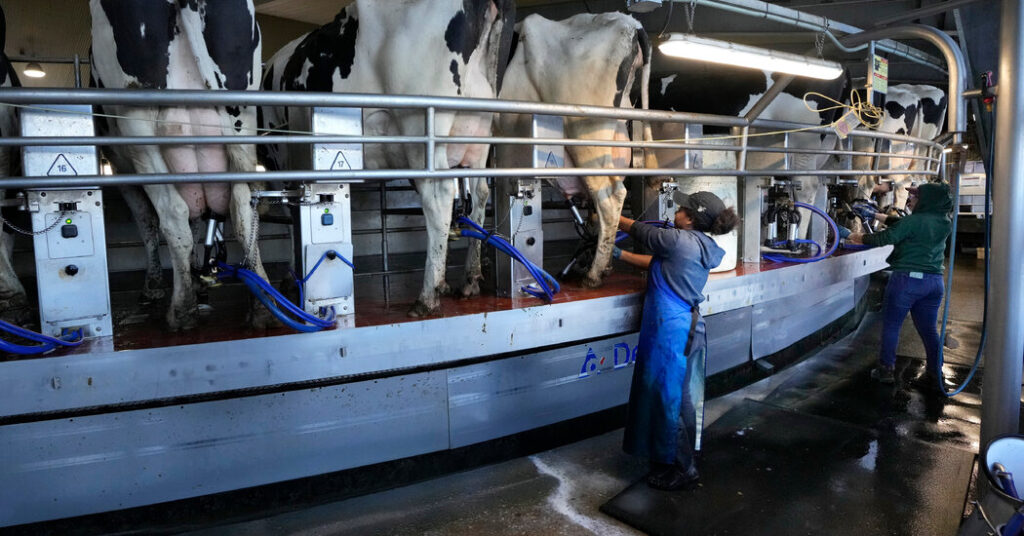Federal regulators have found fragments of chook flu virus in roughly 20 p.c of retail milk samples examined in a nationally consultant examine, the Food and Drug Administration stated in a web based replace on Thursday.
Samples from elements of the nation which might be identified to have dairy herds contaminated with the virus have been extra more likely to check constructive, the company stated. Regulators stated that there isn’t any proof that this milk poses a hazard to shoppers or that reside virus is current within the milk on retailer cabinets, an evaluation public well being specialists have agreed with.
But discovering traces of the virus in such a excessive share of samples from across the nation is the strongest sign but that the chook flu outbreak in dairy cows is extra intensive than the official tally of 33 contaminated herds throughout eight states.
“It suggests that there is a whole lot of this virus out there,” stated Richard Webby, a virologist and influenza professional at St. Jude Children’s Research Hospital.
Dr. Webby stated that he believed it was nonetheless doable to eradicate the virus, which is named H5N1, from the nation’s dairy farms. But it will likely be troublesome to design efficient management measures with out realizing the scope of the outbreak, he stated.
The findings additionally increase questions on how the virus has evaded detection and the place else it is likely to be silently spreading. Some scientists have criticized the federal testing technique as too restricted to disclose the true extent of viral unfold.
Until Wednesday, when the Department of Agriculture introduced necessary testing of dairy cows shifting throughout state traces, testing of cows had been voluntary and primarily centered on cows with apparent signs.
As of Wednesday, simply 23 individuals had been examined for the virus, whereas 44 individuals have been being monitored after publicity to it, based on the Centers for Disease Control and Prevention.
A widespread outbreak in cows would pose a higher danger to farm staff, the dairy business and public well being extra broadly. Sustained unfold amongst cows would give the virus extra alternatives to amass mutations that make it extra transmissible amongst people.
The F.D.A. didn’t present particulars on Thursday relating to the quantity or sources of the samples.
“You’d want to go not just to the places you knew there was activity and cows — you want to go to places where at least there’s no reported” chook flu, Dr. Webby stated.
Experts imagine that the method of pasteurization, by which milk is briefly heated, ought to inactivate this chook flu virus, which referred to as H5N1.
“And when you destroy the virus, it’s going to release genetic material,” stated Samuel Alcaine, a microbiologist and meals scientist at Cornell University. The genetic fragments left behind aren’t able to inflicting an infection.
“It’s not surprising” to search out them in milk, he added. “It doesn’t mean that the milk is not safe.”
Federal officers are nonetheless conducting the time-intensive assessments required to find out whether or not any viable virus stays within the milk after pasteurization. Scientists have stated that prospect may be very unlikely.
Dr. Jeanne Marrazzo, the director of the National Institute of Allergy and Infectious Diseases, stated at a information briefing Wednesday that some federally sponsored researchers had examined for reside virus in retail milk however had not discovered any, an indication that pasteurization had killed the virus earlier than the milk reached grocery cabinets.
Dr. Marrazzo cautioned that whereas the outcomes have been a small pattern, the findings have been “welcome news.”
“To really understand the scope here, we need to wait for the F.D.A. efforts,” she stated.
Finding traces of the virus in 20 p.c of economic milk samples doesn’t imply that 20 p.c of the nation’s dairy herds are contaminated, specialists cautioned. “It’s too early to try to do that back-of-the-napkin kind of calculation,” Dr. Alcaine stated.
Milk from a number of farms is often pooled. If the virus turns up in plenty of milk samples drawn from one pool, it might imply that many cows are contaminated — or {that a} smaller variety of contaminated cows are shedding massive portions of virus, Dr. Alcaine stated.
Even within the latter case, nonetheless, a 20 p.c positivity price would recommend way over 33 herds are contaminated, he famous.
In the Wednesday information briefing, Dr. Donald A. Prater, the appearing director of the F.D.A.’s Center for Food Safety and Applied Nutrition, pointed to the novelty of the analysis effort. No research have ever been accomplished on the results of pasteurization on the chook flu virus in milk, he stated.
Regulators have been analyzing milk at numerous factors within the industrial provide chain, he added, together with milk on grocery cabinets, in addition to finding out potential variations amongst milk merchandise, corresponding to these between entire milk and cream, Dr. Prater stated.


